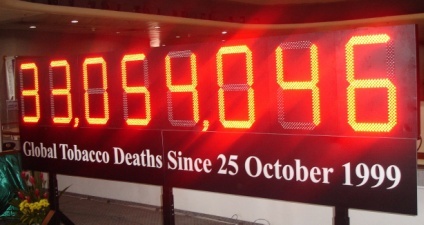 “The World Health Organization (WHO) recently warned that 1 billion people worldwide could die of tobacco-related causes this century unless ‘urgent action’ is taken.” (Reported widely from a WHO press release, February 7, 2008)
“The World Health Organization (WHO) recently warned that 1 billion people worldwide could die of tobacco-related causes this century unless ‘urgent action’ is taken.” (Reported widely from a WHO press release, February 7, 2008)
“In all of history, only 161,000 tons of gold have been mined… More than half has been extracted in the past 50 years.” (National Geographic Magazine, January 2009, p. 52)
Pause for a moment. Think about the number and degree of assumptions, projections, extrapolations, suppositions, conjectures, and outright guesses that are required to come up with each of these statements. Even more astonishing, the second statement is presented as fact; the first at least contains the qualifier “could.”
Let’s see, to project the number of people who could die of “tobacco-related causes” this century (the next NINETY-TWO years), we first have to project population growth, make some heavy-duty assumptions about fertility rates (which have been showing some fascinating variability lately), infant morality rates, and on and on. We then have to make some extrapolations on the percentage of people who will choose to smoke as well as develop some parameters about medical advances in treating cancer or other tobacco-related diseases. Even such a seemingly simple thing as defining what constitutes dying of tobacco related-causes can get surprisingly complicated. Procedures and methods for collecting medical data vary widely from country to country and achieving any kind of uniformity or consistently reliable data can be difficult. Should tobacco be the sole cause of death? Primary? Is it enough if it is a contributing cause? How do you define and measure contributing? And how sure can you be of the true cause of death in the absence of an autopsy (a lot more common in detective thrillers than in real life)?
To my mind, the 1 billion number is a wild guess, a number chosen in hopes it will generate publicity and garner media attention.
“In all of history, only 161,000 tons of gold have been mined… More than half has been extracted in the past 50 years.” First off, the phrase “all of history” is undefined. The last 2,000 years? 4,000 years? 10,000 years? Do we go all the way back to Raquel Welch and “One Billion B.C.”? And who was tracking the gold mine productivity rates back then? If anyone was collecting and publishing gross annual world gold production numbers back in 500 B.C., it has escaped my notice. With a bit more supporting evidence I might buy into the implied number of 80,500 tons mined in the last 50 years; post-1958 I think decent worldwide records may exist, but I also suspect a fair amount of smuggling and illegal mining has gone on that would still require some assumptions and projections.
I am particularly disappointed that National Geographic would present such a number as fact given that they hold themselves out as a “non-profit scientific and educational organization for the increase and diffusion of geographic knowledge.”
When spurious numbers, false data, and quaky, shaky numbers serve as the basis for societal decisions that allocate scare resources, waste and inefficiency occurs. Quality organizations and competent, trustworthy individuals give supporting data and back-up for their statements, preferably peer-reviewed research done by qualified scientists who are truly independent and paid for by institutions without an axe to grind or an agenda to advance.
We would be well served as a society to cultivate a healthy dose of skepticism when it comes to bald pronouncements and unsupported data.


0 Comments